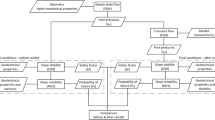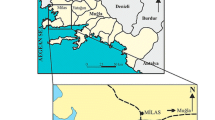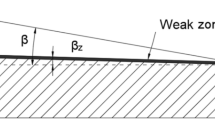Abstract
The paper investigates the stability of deep continuous surface lignite mining slopes. As excavation slopes are made relatively steep for exploitation purposes, the risk of slope instabilities is often appreciable, while the adverse consequences of a major failure are usually severe. Despite these, the design of lignite mining slopes against instability is often empirical, because the mechanisms causing such instabilities are poorly understood. Experience shows that slope instabilities are usually governed by sliding along a sub-horizontal, unfavourably sloping interface between a coal seam and an underlying stiff, high plasticity clay or marl layer, very close to the bottom of the slope. The typical mechanism of such instabilities is triggered by the sharp contrast in stiffness between adjacent lignite and clay/marl layers causing different elastic rebound upon removal of the horizontal confinement during excavation. The paper examines the effect of specific parameters on slope stability by a set of parametric analyses. It is shown that the most important parameter is the inclination of the sub-horizontal lignite–clay interface at the base of the slope. The paper also reviews several slopes in lignite mines which remained stable despite movements with relatively constant velocities reaching up to 100 mm/day, while others have failed when velocities accelerated abruptly although much smaller. These cases show that the absolute magnitude of slope velocity is not always relevant in predicting slope instability, while slope acceleration is a better indicator.

















Similar content being viewed by others
References
Adams BA (2015) Slope stability acceptance criteria for opencast mine design. In: Proceedings of the 12th Australia—New Zealand conference on geomechanics, Wellington, New Zealand, Paper No. 120
Anastopoulos GC, Koukouzas CN (1972) Economic geology of the Southern part of Ptolemais lignite Basin (Macedonia-Greece). Geol Geophys Res XVI(1):189 (in Greek)
Carlà T, Farina P, Intrieri E, Botsialas K, Casagli N (2017) On the monitoring and early-warning of brittle slope failures in hard rock masses: examples from an open-pit mine. Eng Geol 228(2017):71–81. https://doi.org/10.1016/j.enggeo.2017.08.007
Dimitrakopoulos R (ed) (2018) Advances in applied strategic mine planning. Springer, Berlin, p 800
Fukuzono T (1985) A new method for predicting the failure time of a slope. In: Proceedings of the fourth international conference and field workshop on landslides, Tokyo 1985. Tokyo University Press, pp 145–150
Kavvadas M, Agioutantis Z, Schilizzi P, Steiakakis C (2013) Stability and movements of open-pit lignite mines in Northern Greece. In: Proceedings of the 18th international conference on soil mechanics and geotechnical engineering (ICSMGE), Paris, France
Pavlides S, Moutrakis D (1987) Extensional tectonics of northwestern Macedonia, Greece, since the late Miocene. J Struct Geol 9:385–392
Pavlides A, Hristopoulos DA, Roumpos C, Agioutantis Z (2015) Spatial modeling of lignite energy reserves for exloitation planning and quality control. Energy 93:1906–1917
Roumpos C, Papacosta E (2013) Strategic mine planning of surface mining projects incorporating sustainability concepts. In: Proceedings of the 6th international conference on Sustainable Development in the Minerals Industry (SDIMI 2013), 30 June–3 July 2013, Milos Island, Greece, pp 645–651
Roumpos C, Partsinevelos P, Agioutantis Z, Makantasis K, Vlachou A (2014) The optimal location of the distribution point of the belt conveyor system in continuous surface mining operations. Simul Model Pract Theory 47:19–27
Roumpos C, Pavloudakis F, Liakoura A, Nalmpanti D, Arampatzis K (2018) Utilisation of lignite resources within the context of a changing electricity generation mix. In: 10th jubilee international brown coal mining congress “Bełchatów”, Bełchatów, Poland; 04/2018, pp 355–365
Steenbrick J (2001) Orbital signatures in lacustrine sediments. In: The Late Neogene intramontane Florina-Ptolemais-Servia Basin, Northwestern Greece. Mededelingen van de Faculteit Aarwetenschappen. Univ. Utrecht, No 205, p 167
Verma D, Thareza R, Kainthola A, Singh TN (2011) Evaluation of open pit mine slope stability analysis. Int J Earth Sci Eng 4(4):590–600
Author information
Authors and Affiliations
Corresponding author
Additional information
Publisher's Note
Springer Nature remains neutral with regard to jurisdictional claims in published maps and institutional affiliations.
Rights and permissions
About this article
Cite this article
Kavvadas, M., Roumpos, C. & Schilizzi, P. Stability of Deep Excavation Slopes in Continuous Surface Lignite Mining Systems. Geotech Geol Eng 38, 791–812 (2020). https://doi.org/10.1007/s10706-019-01066-x
Received:
Accepted:
Published:
Issue Date:
DOI: https://doi.org/10.1007/s10706-019-01066-x




